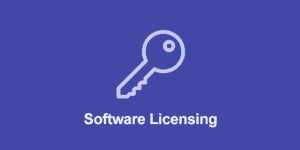What is a software license?

A software license is a document that provides legal rights and duties for the use and distribution of software.
Licenses typically provide end users with the right to one or more copies of the software without infringing the manufacturers' copyrights. It also defines the responsibilities of the parties to the license agreement and can impose restrictions on how the software can be used.
Licensing terms and conditions generally include correct use of the software, limitations of liability, warranties, and disclaimers. They also specify protections if the software or its use violates the intellectual property rights of others.
Software licenses are typically proprietary, free, or open source. The terms of use define whether users and companies can redistribute or copy for further development or use.
How do software contract licenses work?
A software license is a document that declares the rights of the developer and user of a software. It defines how the software can be used and how it will be paid for and the subscription or subscription conditions.
The following are some examples of specifications that a license may include:
- how many times the software can be used for a period;
- how much will the software cost;
- what are the rules for terminating the use contract; and
- what level of access users will have to the source code.
Licenses are typically expressed as an End User License Agreement or an Enterprise License Agreement. The license is an agreement between the user or the user's business organization and the developer. Defines the license terms. A user must agree to the license terms when purchasing the software.
The software also comes with a license key or product key. The key is used to identify and verify the specific software version. It is also used to activate software on a specific computer or device.
Why Licenses and a Software Agreement Matter
A software license establishes the rights of all parties involved with the software: the author, the provider and the end users. It defines the relationship between the software company and the users and explains how they are protected.
How license agreements protect developers
- They protect the intellectual property of developers, their investment in research and development based on copyright laws.
- They limit what other parties can do with the covered software code.
- They limit the liability of the software vendor or manufacturer.
How license agreements protect users
- They define what users can do with software code they haven't written.
- They establish how users remain compliant with software licenses, protect against infringement claims, and limit their legal liability.
- They help users maintain a transparent relationship with software developers and vendors.
- They avoid overspending on licenses by setting clear parameters for how many licenses an organization needs.
What are the different types of licenses?
There are two general types of licenses that differ based on how they are viewed under copyright law.
- Open and free source licenses are often referred to as open source. The source code is available to the customer along with the software product. The customer can usually use the source code to change the software.
- proprietary licenses are often referred to as closed source. They provide customers with operational code. Users cannot freely change this software. These licenses also generally restrict the reverse engineering of software code to obtain the source code.
A more detailed list includes five types of software licenses. It makes finer distinctions between various types of open source licenses and proprietary licenses. This list includes the following:
- Public domain. This software is available for free. Anyone can use it and change it or embed code from this software in an application. However, companies should be careful as changed code may not meet companies' quality and security standards. Companies should beware of ambiguous licenses that appear to be in the public domain but don't explicitly say so.
- Part of Open Source. Developers can link to open source libraries within their software and use any type of licensing for the code.
- Permissive. This type of license will establish certain requirements for distributing or modifying the software. It also has requirements to preserve license, copyright, or trademark notices. There are several variations of permissive licenses, including Apache, BSD (Berkeley Source Distribution) and MIT licenses.
- Copyleft. Licensed code may be distributed or modified as part of an application or software project if all code involved is distributed under the same license. New products containing old code with a copyleft license must comply with the restrictions set out in the old code license.
- Owner. This is the most restrictive license type. Proprietary licenses make it illegal to copy, modify or distribute the software. These licenses provide software owners with the greatest protection against unauthorized use of the software.
How much does a software license or contract cost?
The cost of a license depends on the type and pricing model. There may be a one-time fee that gives users ownership rights to the software program. This approach is considered the traditional way to own software – buy the license upfront (pay up front and earn the usage rights indefinitely. This type of purchase agreement is known as a perpetual license).
Alternatively, the user can pay an upfront fee followed by a subscription plan where payment is made at regular intervals.
License costs are often based on the number of users and devices using the software. They may also depend on the deployment method of the software or API's for example. Costs can increase with add-ons, upgrades, maintenance fees, and other fees. Depending on these factors, software license costs can range from free, or nearly free, to many thousands of dollars.
Tracking software licenses and costs can be particularly difficult across virtualized servers, mobile devices, and cloud operations.
What does a software contract include?
End user license agreements often include basic information about the parties entering the agreement, such as the full names of the parties involved, contact information, and the addresses of the parties. It also likely includes information about the following:
- when the terms of the agreement come into effect (ie when the user accepts the terms and conditions);
- taxes, fees and charges due per user;
- the duration of the agreement or contract;
- termination terms and terms for recovering amounts if canceled during the period covered by the original agreement;
- distribution permissions and limitations;
- user rights to copy the software and make modifications;
- software performance guarantees;
- the number of eligible users;
- maintenance, upgrades and support included;
- how many devices will be able to use the software;
- disclaimer of guarantees;
- transferring the license to another company or person;
- exclusivity or non-exclusivity of the software to any customer; and
- government law and which entity will have jurisdiction over legal disputes over the license.
Cloud Software Licensing
With the migration to the cloud, companies found some more complex challenges involved in license management, or Software Asset Management SAM. Many companies were not prepared for the sudden increase in demand for cloud management software such as IaaS, PaaS and SaaS. Even with the Covid-19 pandemic, companies needed additional licenses for web conferencing, messaging and communications software. They also needed quick access to more security software subscriptions.
For many companies, this unexpected demand and expense meant they had to be creative in their approach to software licensing. Buying everyone a license for every app wasn't always the best answer. Instead, some organizations have chosen to purchase licenses according to an employee's role, using best practices. They also looked at shared leave models, establishing portals where employees can request leave as needed.
Tag: license to use free software proprietary software user license agreement eula validity for licenses hope they have operating systems use licensing open source licenses general law of protection acquisition license protection of personal data program license open source software license for use cloud solutions use fair to use software it outsourcing software management use of software user consent public license gnu gpl commercial software rental licensing document defining licenses for perpetual acquisition personal data what types are developer companies temporary use unlicensed software what types are categories of software security information use of software perpetual acquisition public license user license agreement understand how licensed software works software concepts contact us gnu general public license technical support public license gnu gnu gpl SoftwareONE access to source code data protection main models talk to an expert code software provider Software Licensing Templates ServiceNow Snow
